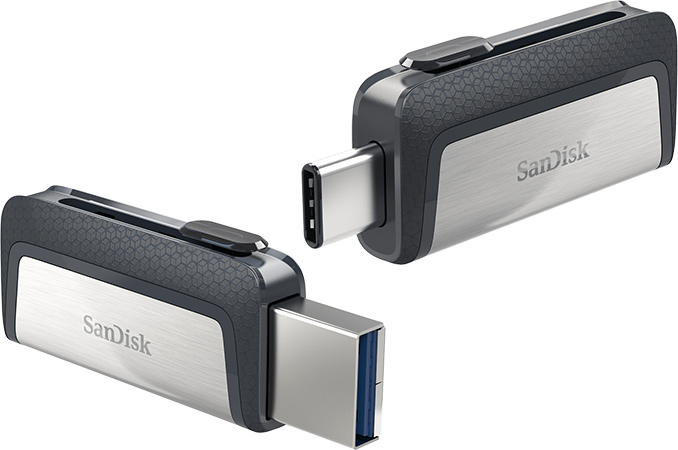SanDisk Unveils New Generation of USB Type-C Flash Drives
by Anton Shilov on June 1, 2016 2:00 PM EST- Posted in
- Computex_2016
- Flash Drive
- SanDisk
- Trade Shows
- USB-C

Last year SanDisk released its first-gen USB flash drives featuring two types of connectors: USB-A and USB-C in a bid to address the growing market of devices featuring USB Type-C, but retain compatibility with billions of legacy devices. This year, SanDisk introduced a new generation of such drives with adifferent design and higher-capacity options.
The second-generation SanDisk Ultra Dual Drive USB Type-C family of USB flash drives includes models with 16 GB, 32 GB, 64 GB and 128 GB of NAND memory. The drives offer transfer speeds up to 150 MB/s and are compatible with all devices featuring USB-A and USB-C receptacles. Furthermore, they are also compatible with SanDisk’s Memory Zone app for Google Android to manage and backup content on devices running the OS.
| SanDisk Ultra Dual Drive USB Type-C Family | |||||||||
| 16 GB | 32 GB | 64 GB | 128 GB | ||||||
| Model (U.S./Europe) | SDDDC2-016G-A46 SDDDC2-016G-G46 |
SDDDC2-032G-A46 SDDDC2-032G-G46 |
SDDDC2-064G-A46 SDDDC2-064G-G46 |
SDDDC2-128G-A46 SDDDC2-128G-G46 |
|||||
| Interface | USB-A, USB-C, 5 Gbit/s | ||||||||
| Sequential Write | 130 MB/s | 150 MB/s | |||||||
| Warranty | 5 Years | ||||||||
| Price | $19.99 | $29.99 | $39.99 | $69.99 | |||||
| Launch Date | Q2 2016 | ||||||||
Introduced commercially in 2015, the USB Type-C connector is rapidly gaining traction among suppliers of PCs, smartphones, tablets and other electronics. For manufacturers of peripherals adoption of new ports by devices is an important factor because they want to address broader audiences with their products. While USB Type-C is gaining popularity, there are still way too many systems featuring USB Type-A ports, which is why it makes a lot of sense to build peripherals compatible with both types of USB.
Moreover, analysts from Strategy Analytics believe that even by 2020 only about 44% of mobile phones will use USB-C, which is a remarkable growth, but which still means that 56% of mobile phones will keep using other types of connectors.
SanDisk and its partners are already selling the new drives with 16GB, 32GB, 64GB and 128GB capacities for U.S. MSRPs of $19.99, $29.99, $39.99 and $69.99, respectively.
Source: SanDisk















25 Comments
View All Comments
ajp_anton - Wednesday, June 1, 2016 - link
"44% of mobile phones will use USB-C, 66% of mobile phones will keep using other types of connectors."There will be 110% of phones?
Zeratul56 - Wednesday, June 1, 2016 - link
Microsoft has to get market share somewhereEden-K121D - Wednesday, June 1, 2016 - link
-10%xype - Wednesday, June 1, 2016 - link
Brütal. :DDanNeely - Wednesday, June 1, 2016 - link
10% of phones will use a proprietary connector and provide dongles supporting either USB connector?xype - Wednesday, June 1, 2016 - link
Theoretically, 10% phones could use both—then those numbers would be correct.shadarlo - Wednesday, June 1, 2016 - link
This man thinks outside of the box. Blew everyone's mind!xype - Thursday, June 2, 2016 - link
I’m trying to think at 110%! :Dbug77 - Thursday, June 2, 2016 - link
If phones would use both, they'd have a Type C connector. If they'd have a Type C connector, they'd be in the 44%.Just nitpicking, since the typo was already fixed.
However, the distinction is useless wrt to the announced product, because if the phone won't have a Type C connector, this stick won't help you much, since the same phone will most definitely not have a Type A connector either. You'll still need an additional cable.
When I read about a Type C stick, I thought: finally, a smaller drive that doesn't need that "giant" connector. But this is a product that goes in a different direction.
James S - Wednesday, June 8, 2016 - link
They would also be in the 66% so it would work out. This was obviously a typo but the logic was sound if there was 10% crossover in the data set.